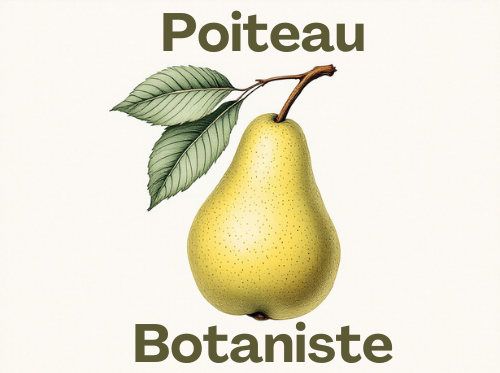Pierre-Antoine Poiteau, a major figure in French botany at the beginning of the 19th century, led a life marked by fascinating scientific expeditions, often carried out in tumultuous political and social contexts.
His travels to Santo Domingo (present-day Haiti) and French Guiana demonstrate his unwavering commitment to science and his love of nature.
Santo Domingo: The origins of a botanical garden in the midst of the Revolution
In 1796, Poiteau received a prestigious mission from the National Museum of Natural History: to create a botanical garden in Saint-Domingue, a colony then in the midst of revolutionary excitement.
- Departure: A Crossing into the Unknown
Aboard the ship Le Fougueux , Poiteau crossed the Atlantic in a voyage that would last nearly a month . Upon arrival, he faced immediate challenges: his official instructions had not been passed on, leaving him without financial or logistical support. His first days were marked by unexpected trials, such as a brief detention under the orders of Commissioner Sonthonax. - Creation and Challenges of the Botanical Garden
Determined, Poiteau set about rehabilitating the Cape Garden, which he restored with passion. However, political tensions and armed struggles between local factions considerably complicated his work. - Meeting with Pierre Turpin: a promising collaboration
In Santo Domingo, Poiteau met Pierre Jean François Turpin, a soldier with exceptional drawing skills. Together, they began to document the local flora. Poiteau wrote a first manuscript, Florule , a sketch of what could have become a vast Flora of Santo Domingo . - Botanical Explorations Despite Dangers
Poiteau followed in the footsteps of Père Plumier (a 17th-century naturalist), collecting specimens in the surrounding mountains. However, revolutionary violence, including the siege of Jacmel and the military campaigns of Toussaint Louverture , forced him to flee to the United States in 1801 to save his collections. It was the United States Consul in Santo Domingo, Edward Stevens, who helped him with this departure. - Highlights of Santo Domingo :
- Cape Town : Epicenter of his work at the botanical garden.
- Turtle Island : Temporary haven for his research.
- Jacmel and Santo Domingo : Places of exploration and collection.
An unfinished project, but notable progress
Despite the surrounding chaos, Poiteau brought back to Paris a rich collection of specimens and drawings. His consignments included 1,200 dried species and several precious manuscripts.
If you would like more information about this trip, I invite you to read the article dedicated to the botanical expedition from Poiteau to Santo Domingo.
French Guiana: Tropical Cultures and New Discoveries
At the end of 1818, after 3 years as head of the royal nurseries at Versailles, and while he was finalizing the work Histoire Naturelle des Orangers , Poiteau was appointed botanist to the king and director of crops in French Guiana. His mission: to study and develop useful tropical plants.
- Settling in Cayenne
Poiteau settled in Cayenne, accompanied by his wife, three of their children, and a member of his in-laws. His two eldest children remained in France to continue their studies. - Work at the Gabrielle plantation
Located near Cayenne, this experimental plantation is the center of his work. Poiteau conducts experiments on the acclimatization of exotic plants there. - Explorations and Challenges
He explored the interior of French Guiana, notably La Mana, where he participated in commissions studying local agriculture. However, administrative and political conflicts there precipitated his recall to France in 1821. - A Lasting Contribution
During his stay, Poiteau sent an exceptional series of living plants to the Paris Museum, considerably enriching French botanical collections. He also wrote reports on tropical agriculture, such as his observations on the grafting of clove trees.
If you would like more information about this trip, I invite you to read the article dedicated to the Poiteau botanical expedition in French Guiana.
Major discoveries and scientific contributions
During his travels, Poiteau enriched botany with numerous discoveries:
- Advances in monocotyledons
He observes that monocotyledons lose their root tap after germination, a fundamental fact for their classification. - New botanical genera
Among his discoveries, he named the genera Thouinia and Stevensia in homage to his benefactors André Thouin and Edward Stevens . - Agricultural discoveries
- Development of table fruits, including improved varieties of oranges.
- Sending rare seeds to the Museum.
- Studies on Arachis hypogaea (ground pistachio / peanut).
- Remarkable collections
- 1,200 dried plant species.
- 600 detailed botanical drawings.
- 383 birds, 16 reptiles and various shells collected to enrich natural sciences.
A timeless legacy
Despite political and personal obstacles, Poiteau’s expeditions left a lasting mark. His work contributed to a better understanding of the flora of the Caribbean and French Guiana, while enriching French botanical collections.
His passion, dedication and artistry continue to inspire, reminding us of the importance of scientific explorers in the construction of knowledge.
📖 Also read: Discover Poiteau’s other major works, such as the Histoire naturelle des orangers, the Traité des arbres fruitiers, nouvelle édition and Pomologie française, or continue with his Horticulture Course which illustrates his sense of transmission even in the twilight of his life.

